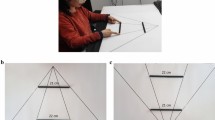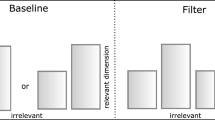Abstract
Perseveration effects in grasping were examined in two experiments. In both experiments, participants reached and grasped different versions of a novel object with their thumb and forefinger using either a horizontal or vertical pincer grasp. The dependent variable was the choice of grasp. In Experiment 1, trials were performed either with or without visual feedback. In Experiment 2, trials were performed either physically or using motor imagery. In both experiments, participants tended to perseverate in their choice of grip. Further, there was no evidence that either the availability of visual feedback during the preceding or current action modulated this effect; mode of responding was similarly inconsequential. The results were interpreted as evidence for a motor priming explanation of perseveration and against an account that relies on perceptual priming.




Similar content being viewed by others
References
Akaike H (1973) Information theory and an extension of the maximum likelihood principle. In: Second international symposium on information theory. Academiai Kiado, Budapest
Bates D, Maechler M, Bolker B (2011) lme4: linear mixed-effects models using S4 classes. R package version 0.999375-42. http://CRAN.R-project.org/package=lme4
Christman SS, Boutsen FR, Buckingham HW (2004) Perseveration and other verbal behaviors: functional dissociations. Semin Speech Lang 25:295–307
Cook R, Press C, Dickinson A, Heyes C (2010) Acquisition of automatic imitation is sensitive to sensorimotor congruency. J Exp Psychol Hum Percept Perform 36:840–852
Craighero L, Fadiga L, Umilta C, Rizzolatti G (1996) Evidence for visuomotor priming effects. NeuroReport 8:347–349
Craighero L, Fadiga L, Rizzolatti G, Umilta C (1998) Visuomotor priming. Vis Cogn 5:109–125
Decety J, Jeannerod M (1995) Mentally simulated movements in virtual reality: does Fitts’ Law hold in motor imagery? Behav Br Res 72:127–134
Dixon P (2008) Models of accuracy in repeated measures designs. J Mem Lang 59:447–456
Dixon P, Glover S (2004) Action and memory. In: The psychology of learning and motivation. Elsevier, San Diego, pp 143–174
Dixon P, Glover S (2009) Perseveration and contrast effects in grasping. Neuropsychologia 47:1578–1584
Dixon P, McAnsh S, Read L (2012) Repetition effects in grasping. Can J Exp Psychol 66:1–17
Duan J, Li Z, Salvendy G (2012) Automatic imitation of risky behavior: a study of simulated driving in China. Traffic Inj Prev 13:442–449
Fischer-Baum S, Rapp B (2012) Underlying causes of letter perseveration errors. Neuropsychologia 50:305–318
Franklin S, Wolpert DM, Franklin DW (2012) Visuomotor feedback gains upregulate during the learning of novel dynamics. J Neurophys 108:467–478
Glover S (2004) Separate visual representations in the planning and control of action. Behav Br Sci 27:3–24
Glover S, Dixon P (2004) Likelihood ratios: a simple and flexible statistic for empirical psychologists. Psychonom Bull Rev 11:791–806
Glover S, Dixon P (2013) Context and vision effects on real and imagined actions: support for the common representation hypothesis of motor imagery. J Exp Psychol Hum Percept Perform (in press)
Griffiths D, Tipper SP (2009) Priming of reach trajectory when observing actions: hand- centred effects. Q J Exp Psychol 62:2450–2470
Gross RG, Grossman M (2008) Update on apraxia. Curr Neurol Neurosci Rep 8:490–496
Guerrero WR, Kumar A, Khaku A, Heilman KM (2010) Spatially adherent graphemic perseveration. Cognit Behav Neurol 23:1269–1273
Heilman KM (2010) Apraxia. Continuum 16:86–98
Heyes C (2011) Automatic imitation. Psychol Bull 137:463–483
Hommel B (2004) Event files: feature binding in and across perception and action. Trends Cognit Sci 8:494–500
Hommel B, Müsseler J, Aschersleben G, Prinz W (2001) The Theory of Event Coding (TEC): a framework for perception and action. Behav Br Sci 24:849–878
Hurley SR, Lee TD (2006) The influence of augmented feedback and prior learning on the acquisition of new bimanual coordination patterns. Hum Mov Sci 25:339–348
Janczyk M, Heinemann A, Randolph BAD, Pfister R (2012) Instant attraction: immediate action-effect bindings occur for both stimulus- and goal-driven actions. Front Cognit 3:446
Jax SA, Coslett HB (2009) Disorders of the perceptual-motor system. Adv Exp Med Biol 629:377–391
Jax SA, Rosenbaum DA (2007) Hand path priming in manual obstacle avoidance evidence that the dorsal stream does not only control visually guided actions in real time. J Exp Psychol Hum Percept Perform 33:425–441
Jax SA, Rosenbaum DA (2009) Hand path priming in manual obstacle avoidance: rapid decay of dorsal stream information. Neuropsychologia 47:1573–1577
Jeannerod M (1994) The representing brain: neural correlates of motor intention and imagery. Behav Br Sci 17:187–245
Kelso JAS, Buchanan JJ, Murata T (1994) Multifunctionality and switching in the coordination dynamics of reaching and grasping. Hum Mov Sci 13:63–94
Kim EJ, Lee BH, Park KC, Suh MK, Heilman KM, Na DL (2009) Consecutive versus return motor perseveration during line cancellation task in hemispatial neglect. Cogn Behav Neurol 22:122–126
Kleinman JT, Dubois JC, Newhart M, Hillis AE (2013) Disentangling the neuroanatomical correlates of perseveration from unilateral spatial neglect. Behav Neurol 26:131–138
Leighton J, Heyes C (2010) Hand to mouth: automatic imitation across effector systems. J Exp Psychol Hum Percept Perform 36:1174–1183
Milgram P (1987) A spectacle-mounted liquid crystal tachistoscope. Behav Res Method Instrum Comput 19:449–456
Moses MS, Nickels LA, Sheard C (2004) “I’m sitting here feeling aphasic!” A study of recurrent perseverative errors elicited in unimpaired speakers. Br Lang 89:157–173
Rapin I, Dunn M (1997) Language disorders in children with autism. Semin Pediatr Neurol 4:86–92
Ronchi R, Algeri L, Chiapella L, Spada MS, Vallar G (2012) Spatial neglect and perseveration in visuomotor exploration. Neuropsychol 26:588–603
Rosenbaum DA (1980) Human movement initiation: specification of arm, direction, and extent. J Exp Psychol Gen 109:444–474
Rosenbaum DA, Jorgensen MJ (1992) Planning macroscopic aspects of manual control. Hum Mov Sci 11:61–69
Ruby P, Decety J (2001) Effect of subjective perspective taking during simulation of action: a PET investigation of agency. Nat Neurosci 4:546–550
R Development Core Team (2012) R: a language and environment for statistical computing. R Foundation for Statistical Computing, Vienna, Austria. ISBN 3-900051-07-0, http://www.R-project.org/
Shadmehr R, Smith MA, Krakauer JW (2010) Error correction, sensory prediction, and adaptation in motor control. Ann Rev Neurosci 33:89–108
Short MW, Cauraugh JH (1997) Planning macroscopic aspects of manual control: end-state comfort and point-of-change effects. Acta Psychol 96:133–147
Thomaschke R, Hopkins B, Miall RC (2012a) The planning and control model (PCM) of motorvisual priming: reconciling motorvisual impairment and facilitation effects. Psychol Rev 119:388–407
Thomaschke R, Hopkins B, Miall RC (2012b) The role of cue-response mapping in motorvisual impairment and facilitation: evidence for different roles of action planning and action control in motorvisual dual-task priming. J Exp Psychol Hum Percept Perform 38:336–349
van der Wel RP, Fleckenstein RM, Jax SA, Rosenbaum DA (2007) Hand path priming in manual obstacle avoidance: evidence for abstract spatiotemporal forms in human motor control. J Exp Psychol Hum Percept Perform 33:1117–1126
Vitkovitch M, Rutter C (2000) The effects of response stimuli interval on error priming in sequential object naming. Vis Cogn 7:645–670
Vitkovitch M, Humphreys GW, Lloyd-Jones T (1993) On naming a giraffe a zebra: picture naming errors across different object categories. J Exp Psychol Learn Mem Cogn 19:243–259
Wolpert DM, Flanagan R (2001) Motor prediction. Curr Biol 18:R729–R732
Wolpert DM, Ghahramani Z (2000) Computational principles of movement neuroscience. Nat Neurosci Suppl 3:121–1217
Yuen I, Davis MH, Brysbaert M, Rastle K (2010) Activation of articulatory information in speech perception. Proc Nat Acad Sci 107:592–597
Author information
Authors and Affiliations
Corresponding author
Rights and permissions
About this article
Cite this article
Glover, S., Dixon, P. Perseveration effects in reaching and grasping rely on motor priming and not perception. Exp Brain Res 226, 53–61 (2013). https://doi.org/10.1007/s00221-013-3410-y
Received:
Accepted:
Published:
Issue Date:
DOI: https://doi.org/10.1007/s00221-013-3410-y




